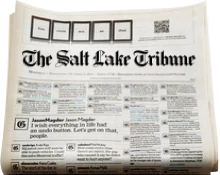This is an archived article that was published on sltrib.com in 2006, and information in the article may be outdated. It is provided only for personal research purposes and may not be reprinted.
Gov. Jon Huntsman Jr. formally abandoned his pet tax-reform proposal Monday after learning that more calculation errors have been uncovered that would nearly triple its price tag to more than $200 million.
Huntsman's hopes for a special tax session this month to pass his income-tax reform were crushed when a $35 million blunder - increasing its cost by half - was made public last month.
Huntsman's third version of a "flatter, fairer" tax - dubbed H3 in his honor - was originally projected to return $70 million to taxpayers, while putting school funding on a stable and more predictable long-term footing.
But that revised $105 million revenue bite jumped above $200 million last week, when tax analysts found more errors, key legislators confirmed.
Senate Revenue and Taxation Chairman Committee Curtis Bramble, R-Provo, said the problem was discovered when a legislative tax expert ran numbers on the plan and found the cost would be between $208 million and $243 million, depending on whether retirement income was exempted.
Tax Commission members could not immediately explain the discrepancy, Bramble said.
Huntsman attempted to downplay the problem with the numbers by stressing that he has embraced a different plan.
"While tax reform is alive and well, the H3 proposal is deader than a doornail," Huntsman spokesman Mike Mower acknowledged Monday.
The governor will call next week for a routine special session for lawmakers to correct some technical errors in legislation. But Mower said Huntsman will add an additional task for the lawmakers: coming up with a way to check the Tax Commission's math.
Legislators are already drafting a bill that would allow their analysts to share Tax Commission projection data.
"We will be putting that item on the call for the special session," Mower said. "Our goal is to build confidence in the numbers that will be analyzed prior to the adoption of any tax reform. We want to make certain that legislators and other officials and all Utahns are comfortable with the way tax numbers are generated and reviewed."
Exactly what tax reform will look like and even when it could be enacted remains unclear. Huntsman and some House members are already floating a "dual track" tax-reform scheme that would allow taxpayers to choose to file under either the existing tax code, with its myriad deductions and credits, or a flat tax of 4.8 percent with no deductions.
But Republican Senate leaders - including Senate President John Valentine and Bramble, tax professionals who are backers of the flatter tax - are skeptical of the bifurcated proposal. Giving filers a choice of filing systems every year would just increase confusion, not only for taxpayers, but also for state tax planners, they said.
Tax Commission officials refused to discuss the newest projection errors until they are released Wednesday at a meeting of the Revenue and Taxation Committee.
"They've been working on those figures. They don't want to make those numbers public until then," spokesman Charlie Roberts said. Tax commissioners did not respond to requests for interviews.
Rep. John Dougall, who sponsored and helped structure Huntsman's previous reform plans and originated the two-track concept, was still trying Monday to get to the bottom of the $208 million miscalculation, he said. The $35 million mistake discovered earlier resulted from failing to include deductions for money earned outside of Utah.
Huntsman's office also was reluctant to discuss the errors and the revised $200-million-plus cost for the flatter tax.
"We are no longer supporting H3. We moved forward with analysis on the dual-track plan," Mower said.
One thing emerging from the mistakes is a united call for increased scrutiny of tax figures.
"We are starting the process to get peer review and double-checking of the Tax Commission's numbers," Dougall said. "When we do get numbers, they will be better numbers."
Under current law, anyone looking at the information must be deputized by the Tax Commission. But allowing an executive agency to deputize legislative staff members would violate the separation of powers. Lawmakers hope they can craft legislation that will allow their analysts to join the governor's and the Tax Commission's economists in viewing generic tax data that would not violate confidentiality rules.
Mower acknowledged that public confidence in any state revenue numbers, including the surplus itself, has been undercut.
"That's why we are moving forward to expand the number of people in government who are able to analyze tax information," he said. "At a minimum, you would have three sets of eyes reviewing the information - not just one."

